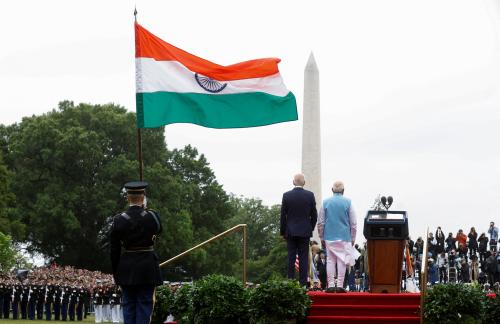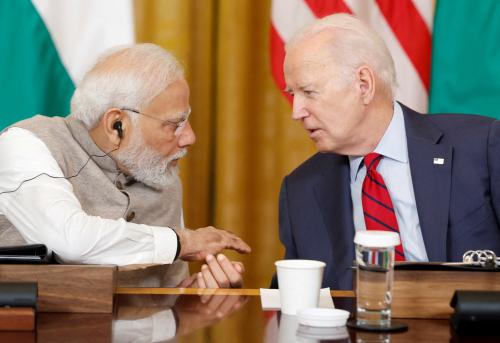Content from the Brookings Institution India Center is now archived. After seven years of an impactful partnership, as of September 11, 2020, Brookings India is now the Centre for Social and Economic Progress, an independent public policy institution based in India.
In this India-U.S. Policy Memo, Charles Ebinger and Tim Boersma write that for India to successfully transition to a more sustainable energy policy, its central and state governments need to embark on bold reforms. They highlight some ways in which these governments can also engage and collaborate with the United States.
As a number of Indian policymakers have noted, Indian energy policy has not been on a sustainable course. With imports of natural gas, coal and oil to fuel its economic growth soaring, the drain on the balance of payments and the impact on the government’s ability to deal with other pressing economic issues (such as health, education, and infrastructure) are both critical problems. To deal with these issues, the central and state governments must embark on bold reforms.
First and foremost, the challenges that Indian policymakers face have to be addressed domestically. There are, however, also a number of opportunities to engage and collaborate with countries like the United States. Below are some tangible examples.
Technical expertise: The U.S. can provide significant technical expertise on addressing some of the most urgent reforms that have to take place at the domestic level in India, such as safeguarding payments for electricity in all layers of society, increasing transparency and reducing losses, and ensuring that, in particular, large governmental entities, including the military, start paying their electricity and natural gas bills.
Shale development: According to the U.S. Energy Information Administration, India has an estimated 100 trillion cubic feet of technically-recoverable shale gas under its soil. Experiences in the U.S. provide lessons on how to extract these resources responsibly. Though private-sector actors are most knowledgeable in this respect, the U.S. State Department’s Bureau of Energy Resources also engages with other governments to bring experts together and exchange best practices based on U.S. experiences.
Renewable energy development: India has very significant potential for domestic renewable energy development, yet difficulty realizing its ambitious goals. A part of the problem links back to domestic balance of payments issues and the resulting high cost of capital. Still, India has developed very strong expertise in both wind and solar technology, and is deploying this on a significant scale. This is all the more important for the poorer regions in India, where distributed generation is more likely to provide access to electricity that is so direly needed. Though the U.S. on the federal level does not have an image of being a frontrunner in climate and renewable policies, in fact, on the state level there are an increasing number of very ambitious policy frameworks and incentive schemes. It would be valuable for American and Indian policymakers—at both the central and state level—to share information, experiences and lessons in this regard.
Carbon capture and sequestration (CCS): India and the U.S. have a shared interest in further developing CCS technology to help address the air quality problems that come with abundant fossil fuel usage. Though in recent years natural gas has become more competitive for electricity generation in the U.S., it is worth noting that, until at least 2035, coal is expected to remain the dominant feedstock in the U.S. In India, coal usage will continue as it is considered cheaper, it is available domestically (though India imports coal as well), and much of India’s power generating capacity is coal-based. Furthermore, it is seen as fueling economic growth. If both countries acknowledge the challenge of global warming, however, making CCS economically viable must be a key priority.
Civil nuclear cooperation: India and the U.S. should continue to try to implement their civil nuclear agreement. Under this initiative, Indian and U.S. companies can increase their collaboration and expand the share of this clean source of energy.
Energy efficiency: India and the U.S. can multiply existing initiatives on energy efficiency. One way could be in designing the megacities of tomorrow. If tomorrow’s cities are to be more sustainable, it is essential to implement binding energy efficiency standards, distributed generation for electricity, and standards for housing. Both Indian and U.S. firms have technological expertise to realize this, and policy and regulations can be designed to incentivize the exchange of knowledge, especially on day-to-day implementation.
Liquefied natural gas (LNG) exports: These days an often quoted ambition is the desire from major energy importing countries to tap into U.S. shale gas by importing U.S. LNG. This is largely based on an inflated promise. It remains to be seen how much U.S. natural gas will eventually come to the market and be competitive (we believe between 6-8 bcf/day). Furthermore, whatever LNG makes it to the market will be sold to the highest bidder—and these are mainly business rather than government decisions. Indian firms could certainly be among those bidders, but it is important to have realistic expectations in this respect.



Commentary
Op-edIndian Energy Market Development: Opportunities for Collaboration with the U.S.
September 23, 2014